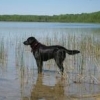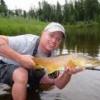
scel
Members-
Posts
546 -
Joined
-
Last visited
-
Days Won
37
scel last won the day on May 2 2020
scel had the most liked content!
Recent Profile Visitors
2,310 profile views
scel's Achievements

Cutthroat Trout (6/10)
329
Reputation
-
For pike in a pontoon, I would simply get accustomed to controlling via the 'gill grip'. A cradle is great in a boat with a partner where you have a lot of lateral space to work with, but the 1m of real-estate between my legs is already filled with many things I wish to protect. Nets are just horrible because pike almost always seem to thrash once removed from the water. I have landed many 35+" fish with my pontoon boat.
-
The goal is to give people incentive to stay at home by eliminating the freedom that allows us to travel. As well, the problem was a huge uptick in outdoor activities. Parks require maintenance and upkeep. More people in the parks means more people to maintain the parks. Unfortunately, people do not seem to understand how to take care of their own garbage. Closing parking lots drastically reduces upkeep and reinforces social distancing. Cigarette butts, pop/beer cans, fast food wrappers...these are all things that go up to an individuals mouth, and then someone has to clean it up. It frustrates me because I am not one of the people who abuses these resources, but I am the kind of guy who will put my empty coffee cup into a garbage can. If I notice I have an extra empty cup in the car, I will also put it into the garbage can. Despite my good intentions and relative innocence, I have just become part of the problem.
-
I suggest that you think about it this way... If you were to seriously get hurt and require emergency care, would you go to the same hospital if you suffered a similar injury at your home? If the answer is 'no', then do not go. This disease can very quickly over-run a medical system. If we stick to this path, I am cautiously optimistic that we could see a relaxation in the mitigation strategies in the next few weeks especially if local health care networks are not unnecessarily stressed.
-
So, I am fishing the Bow at dark last night. It is not uncommon to encounter beavers. They ruin the fishing, so when the beaver starts getting slap happy, it is time to move on. This beaver continues to follow me down the river ruining every run. So, I walk down a couple runs, then sit for 15 minutes. I start swinging my streamer. Sure enough, beaver shows up and starts slapping, so I angrily start stripping in my line to pack up and leave, then I hook up. I thought this was a monstrous fish, but it turns out that it was the beaver. I am using 20# fluoro, so breaking the line will not be an easy task, so I start reeling it in. The line eventually just snaps in the tippet section. The beaver then swims to shore about 4m away from me, looks around, takes a breather, then leaves. I admit that I dislike beavers. But not the beaver specifically, I just dislike that they ruin the fishing. My first instinct was 'you deserved it', but that is just being an a$$hole. The beaver is just doing beaver things. I am certain there is no part of the beaver manual that includes 'how to treat fly anglers'. I do not think the beaver linked me with what happened or it would not have swum to shore so close to me, so there was no lesson learned either. I feel badly because this beaver has an articulated streamer impaled into it, and really, it did not deserve it. Or it is tangled in line, which I think is actually scenario It is debarbed, so it could be removed by simply pulling it out, if the beaver has the wherewithal to do it. A beaver is more than capable of cutting fluorocarbon line if it is tangled. Is there anything I could do or is this simply one of those 'mother nature is kind of cruel' moments?
-
These are technically non-dominant traits---they are recessive traits. Furthermore, the slash is ironically a non-definitive for cutthroat trout. The orange slash can pop up in rainbow trout populations with no contact with cutthroat trout (the gene would have to be present in rainbow trout in order for them to produce viable offspring), but it does serve as a good indicator if coupled with any of the primary characteristics. The primary physical taxonomic features that define a cutthroat trout are basibranchial teeth (little teeth-like protrusions on the tongue) and jaw that extends past the eye orbital. The most reliable secondary characteristic is the spotting pattern---higher density near the tail. Although, this characteristic can be easily washed out of cutthroat population (like those in the Oldman drainage). In this case, the jaw clearly extends beyond the eye. The secondary characteristic of increased spotting near the tail is also present. And, of course, the orange slashes are present. Spotting pattern extends to the head, but not a reliable marker. If there were basibranchial teeth, you might have close to a pure cutthroat. Almost all Alberta populations of cutthroat have been hybridized to some degree with rainbow trout, so technically almost every cutthroat is a cuttbow. I think the only 'pure' populations are in a couple lakes in the Banff park. source: wife is trained taxonomist and practicing biologist. EDIT: It has been pointed out to me, and I was scolded by my wife, that there are several statistically genetically pure pockets of cutthroats. Still it is estimated that approximately 70% of the known populations have been interbred with rainbow trout.
-
Posting Images Of Fish On The Fly Fish Calgary Board
scel replied to Pacres's topic in General Chat - Fly Fishing Related
Holy thread necromancy! I love the comment is more valid today than it was 11 years ago, when people were just starting to carry cameras around with them full time. -
Rewarding illegal stocking
scel replied to DonAndersen's topic in General Chat - Fly Fishing Related
I would revolt on this concept. I love Cow Lake. It may have been more popular as a trout fishery, but it is a fantastic pike fishery, especially through May and June. In mid June, the topwater pike fishing can be absolutely amazing. While there may not be historically pike or perch in Cow Lake, they are naturally occurring in many lakes in the area. Even if it were converted back to a trout fishery, there is nothing preventing the same thing from happening again. -
Thanks for help everyone. I tried all the boots suggested. I went with the Patagonia River Tractors. I did not try the Patagonia Danner River Tractors. I could not absorb the price tag to afford to be an early adopter. Literally everything on this boot can be fixed or repaired, but the price tag for a vibram resole starts at $150. The Danner boots are meant to replace the existing River Tractors, so the 'old' models were on a fairly steep discount. The River Tractors are as supportive as the G3s and ended up being a little cheaper than the Freestones. I will keep my old pair of garbage boots for the few days that I get to spend in a boat.
-
My wife is a biologist. She will not permit me to get felt soles. To be honest though, getting to the river is far more dangerous than falling into the river itself. Falling into the river can ruin the day, but the only times that I have fallen and hurt myself have been getting down to the river. In both cases, my felt soles slipped on the muddy trails or on wet grass. Vibram soles and cleats have been my go-to for 8+ years now. The Simms Ultralights were de-facto top contenders on my list. I will be shopping this week. I will let you know if I see them.
-
Thanks for all the input everyone. I have a feeling that Simms Freestone boots are likely the a top contender.
-
I was intrigued by Patagonia's boots, but $685!!! Do not get me wrong---I want a pair. It might be worth it if they are legitimately the last boots that I would need to buy. Have you looked into what re-soling costs?
-
I have worn a couple pairs of Freestones. They were pretty good. They lasted the the same amount of time as the G3 Guide boots but I found the Freestones to be much more comfortable. I know some people swear by the G3. I had never heard of Chota. They seem to have a similar construction to the Vaportreads. I will look into them. Thanks.
-
Hivemind: I am in the market for new wading boots. I have been buying Simms boots for the last few years. I get 18-24 months out of a pair of boots before they completely fall apart. I put in a lot of footwork every season. From May until the end of September, I think guessing 20km per week walking the banks would be a completely fair assumption. I have worn G3s. I found them to be heavy and cumbersome. My favourite boots ever were the Simms Vaportrail (or Vaportread or something like that), but they have been discontinued. These boots were light and comfortable---I was leery of the synthetic materials, but they drain and dry much faster than leather. The only downsides to the synthetics is during colder conditions. I have my eye on the Orvis ultralight, but I do not know anyone who has tried them. Does anyone have any experience with them? In fact, the whole Orvis line of boots looks great, but it seems Simms dominates the market here. I have owned a couple pairs of Korkers, but I have not found the comfortable, and the first pair barely made it 3months before the upper started falling part. I like the flexibility, but comfort is paramount. What boots do you wear? How do they hold up to walking?
-
It really is this simple. I would probably fish a black-n-white clouser minnow with a backswimmer dropper.





